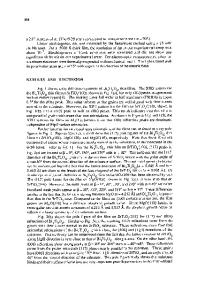Ferroelectric and Piezoelectric Properties of Epitaxial Pb(Yb 1/2 Nb 1/2 )O 3 -PbTiO 3 Films
- PDF / 98,632 Bytes
- 6 Pages / 612 x 792 pts (letter) Page_size
- 27 Downloads / 379 Views
Ferroelectric and Piezoelectric Properties of Epitaxial Pb(Yb1/2Nb1/2)O3-PbTiO3 Films Takeshi Yoshimura and Susan Trolier-McKinstry Materials Research Laboratory, The Pennsylvania State University, University Park, PA 16802-4801, U.S.A. ABSTRACT (1-x)Pb(Yb1/2Nb1/2)O3-xPbTiO3 (PYbN-PT, x=0.5) epitaxial films were grown on (001)SrRuO3/(001)LaAlO3 and (111)SrRuO3/(111)SrTiO3 substrates by pulsed laser deposition. (001)PYbN-PT epitaxial films with high phase purity and good crystalline quality were obtained for a wide range of deposition rates (60-90 nm/min) and temperatures (620-680 °C). (111)PYbN-PT films were also obtained at temperatures in the range of 600 °C to 620 °C. The ferroelectric and piezoelectric properties were investigated on both (001) and (111) PYbN-PT films. The remanent polarizations of (001)PYbN-PT and (111)PYbN-PT films were as high as 34 µC/cm2 and 26 µC/cm2, respectively. On (001)PYbN-PT films with a thickness of 900 nm, an e31 coefficient of -13 C/m2 and an aging rate of 2.5% per decade were observed.
INTRODUCTION Piezoelectric thin films have received considerable attention in recent years for their potential application to microelectromechanical systems (MEMS) such as microsensors and microactuators [1]. Since Pb(Zr,Ti)O3 (PZT) exhibits attractive piezoelectric responses, PZT thin films have been widely studied [2-4]. However, the piezoelectric coefficients (dij) measured for PZT films are limited to those values typical of hard PZT ceramics. Recently, it has been reported that single crystals of relaxor ferroelectrics-PbTiO3 solid solutions such as Pb(Mg1/3Nb2/3)O3-PbTiO3 (PMN-PT) and Pb(Zn1/3Nb2/3)O3-PbTiO3 (PZN-PT) exhibit very large piezoelectric responses [5]. A piezoelectric d33 coefficient of 2500 pC/N has been observed for oriented rhombohedral crystals, even though is the polar direction. Furthermore, the response appears to be largely intrinsic. Therefore epitaxial films of relaxor ferroelectrics-PbTiO3 solid solutions may also exhibit high piezoelectric responses [6]. Maria et al. [7] have reported that PMN-PT epitaxial films show enhanced piezoelectric coefficient relative to PZT films. In the present study, we focus on (1-x)Pb(Yb1/2Nb1/2)O3-xPbTiO3 (PYbN-PT) epitaxial films. To compare with the piezoelectric properties of single crystals of relaxor ferroelectrics-PbTiO3 solid solutions, (001) and (111) epitaxial PYbN-PT films were prepared. There are several reports concerning the synthesis and characterization of PYbN-PT bulk ceramics [8,9]. PYbN-PT with compositions in the range from x=0.2 to 0.49 exhibits relaxor ferroelectric behavior. Since PYbN-PT has the highest Curie point (~360 °C) near the morphotropic phase boundary (x~0.5) of the known relaxor ferroelectric-PbTiO3 solid solutions, piezoelectric properties with good temperature stability can be expected. Although Bornand et al. [10-12] have reported on the growth and ferroelectric properties of PYbN-PT epitaxial films, to the best of the authors' knowledge, there are no reports about the piezoelectric properties of PYb
Data Loading...











